
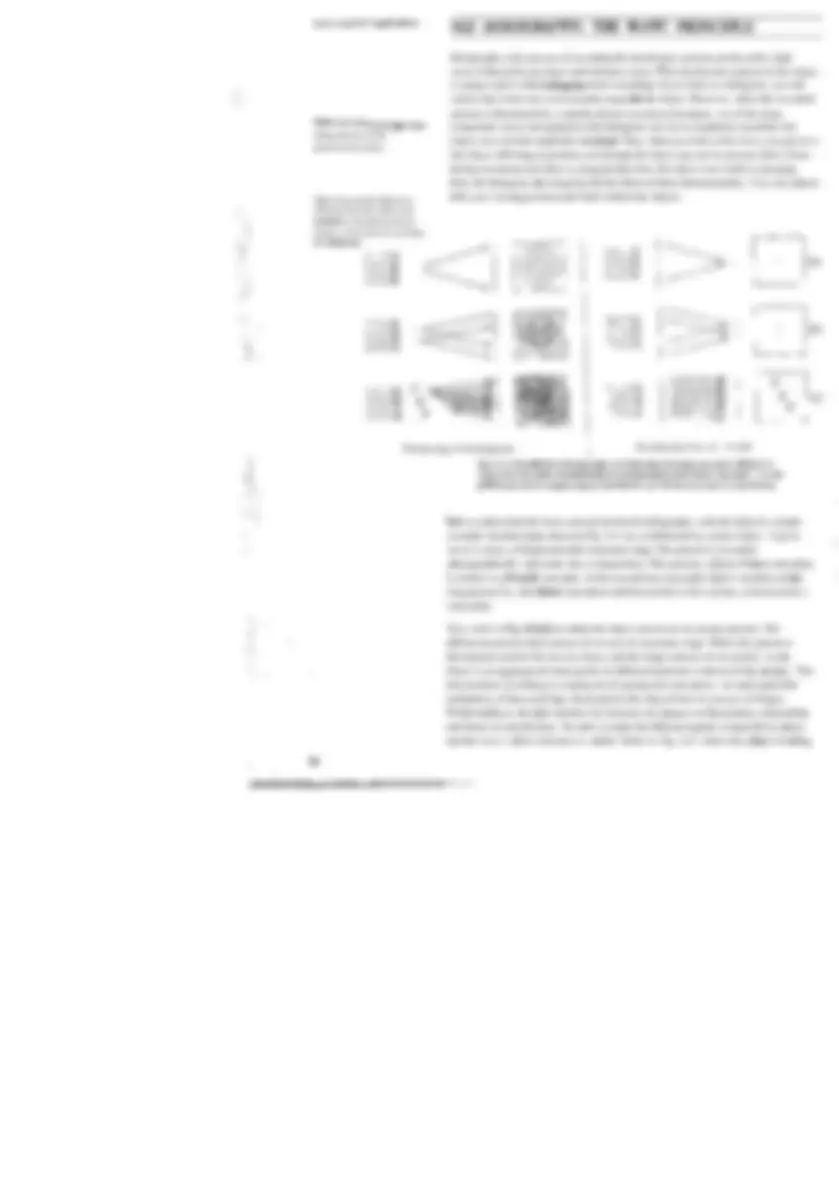
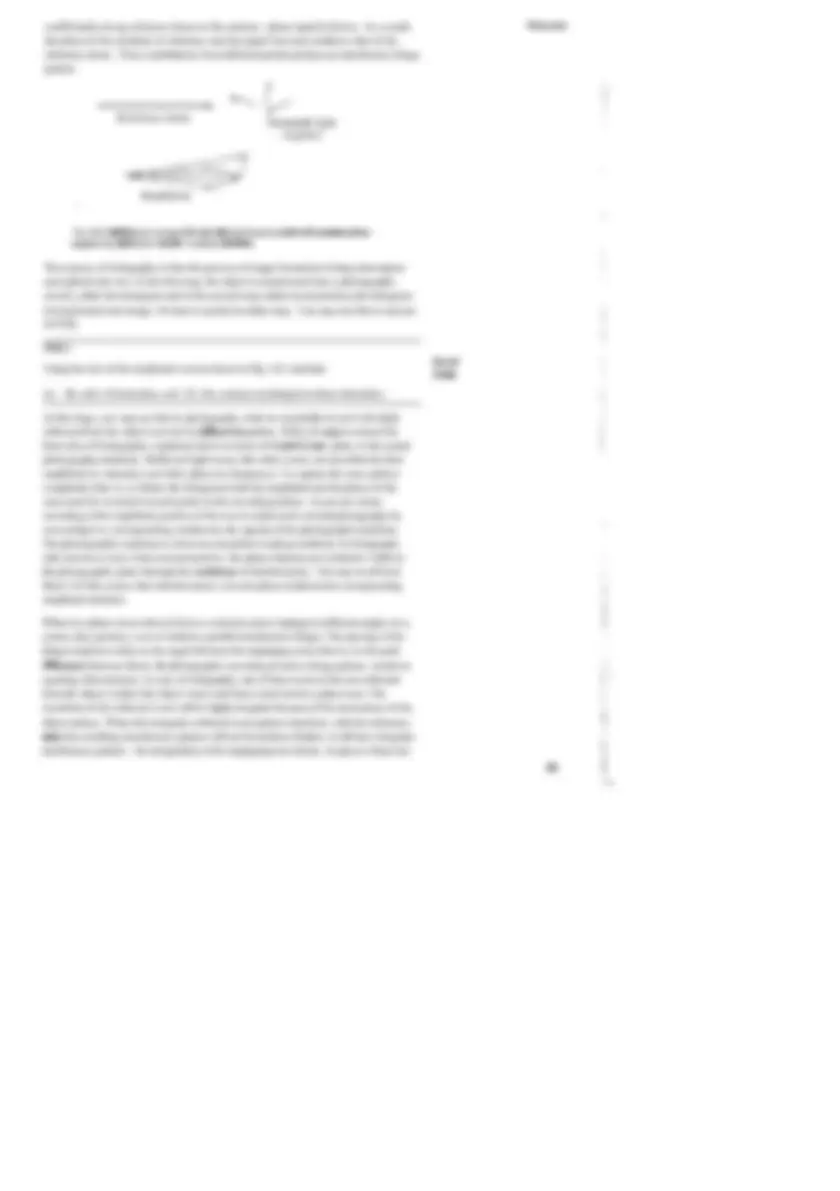
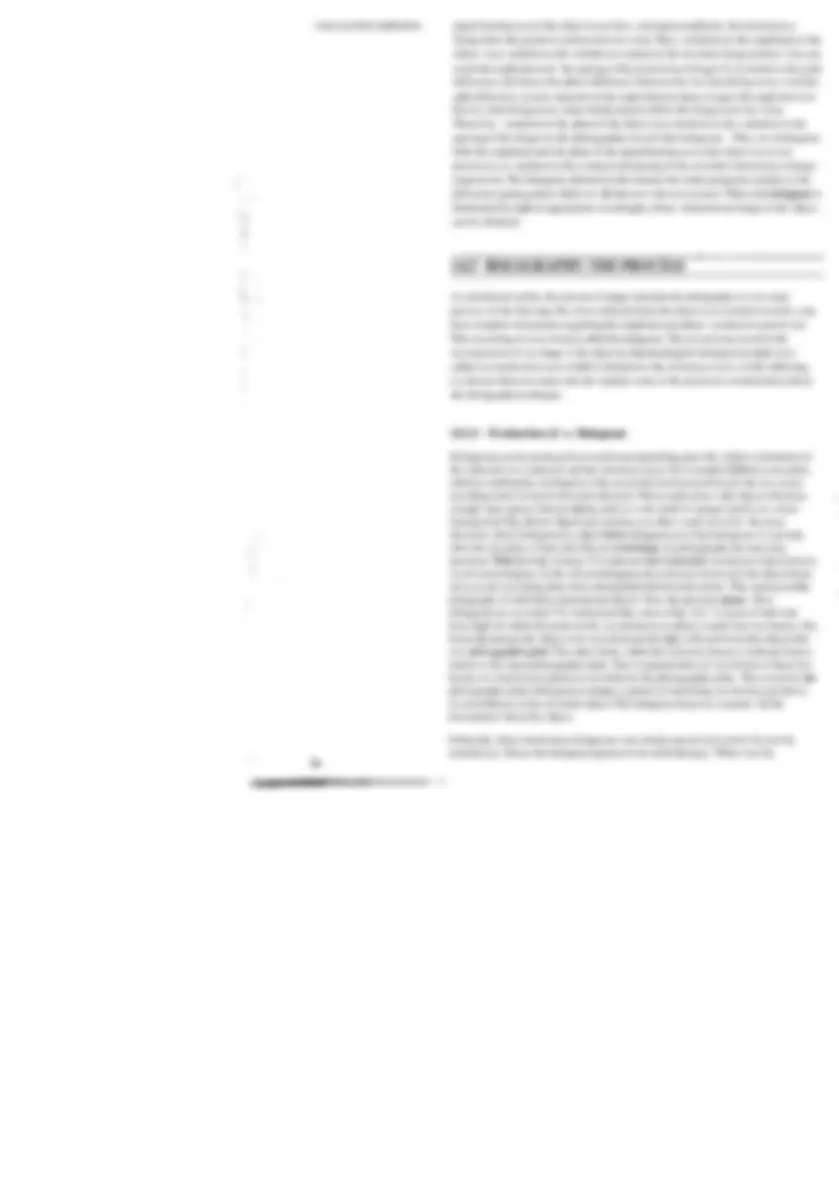
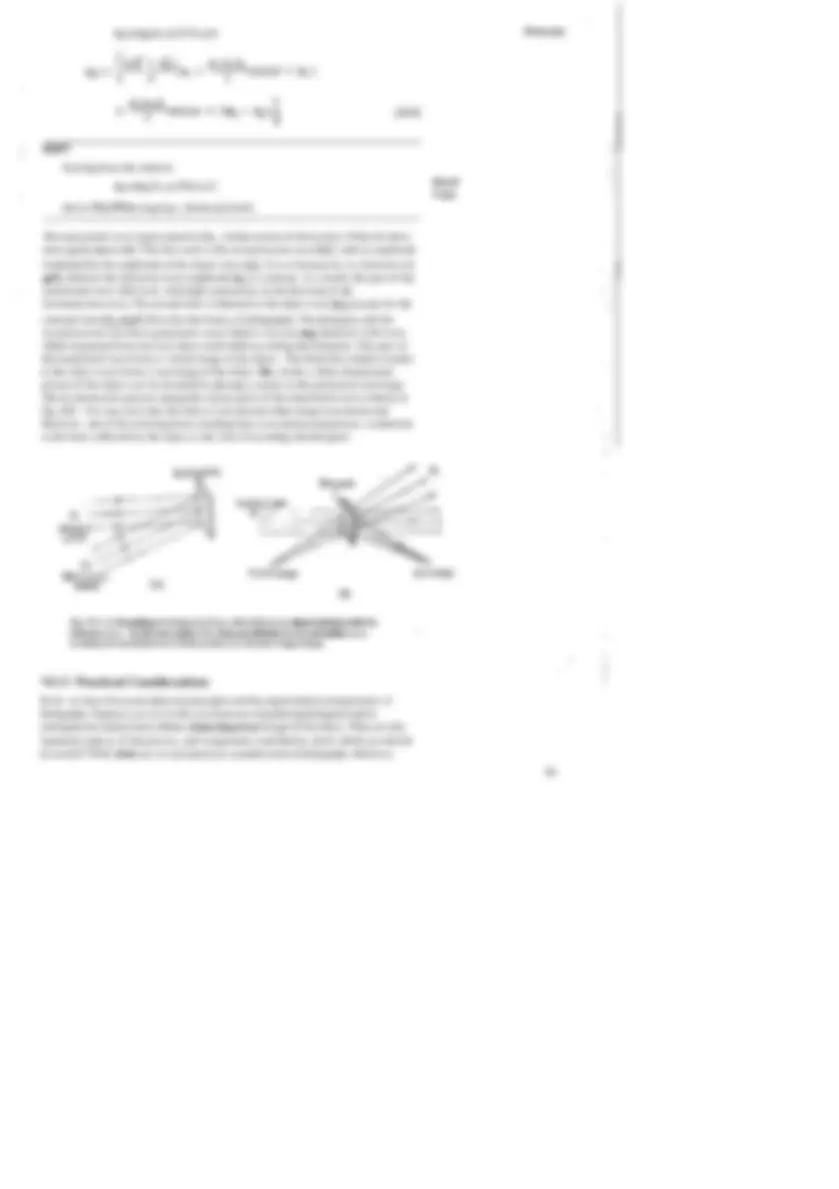

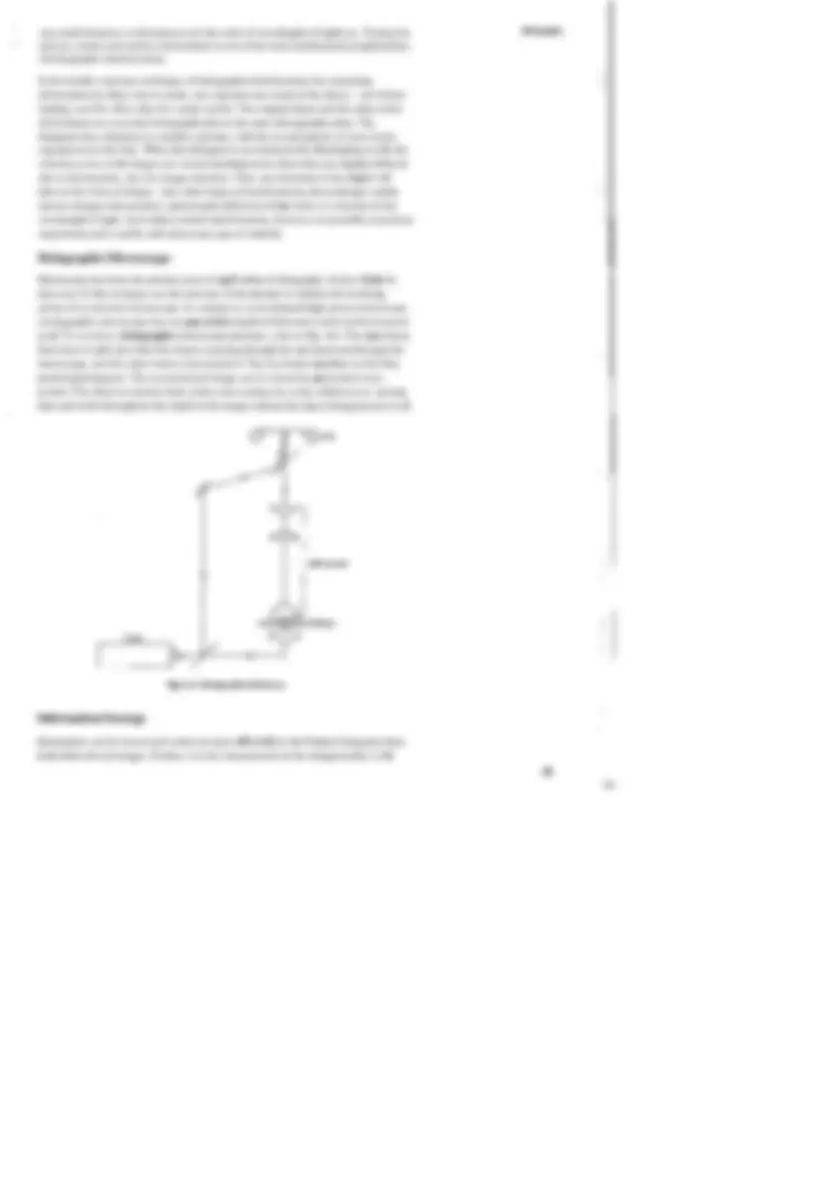
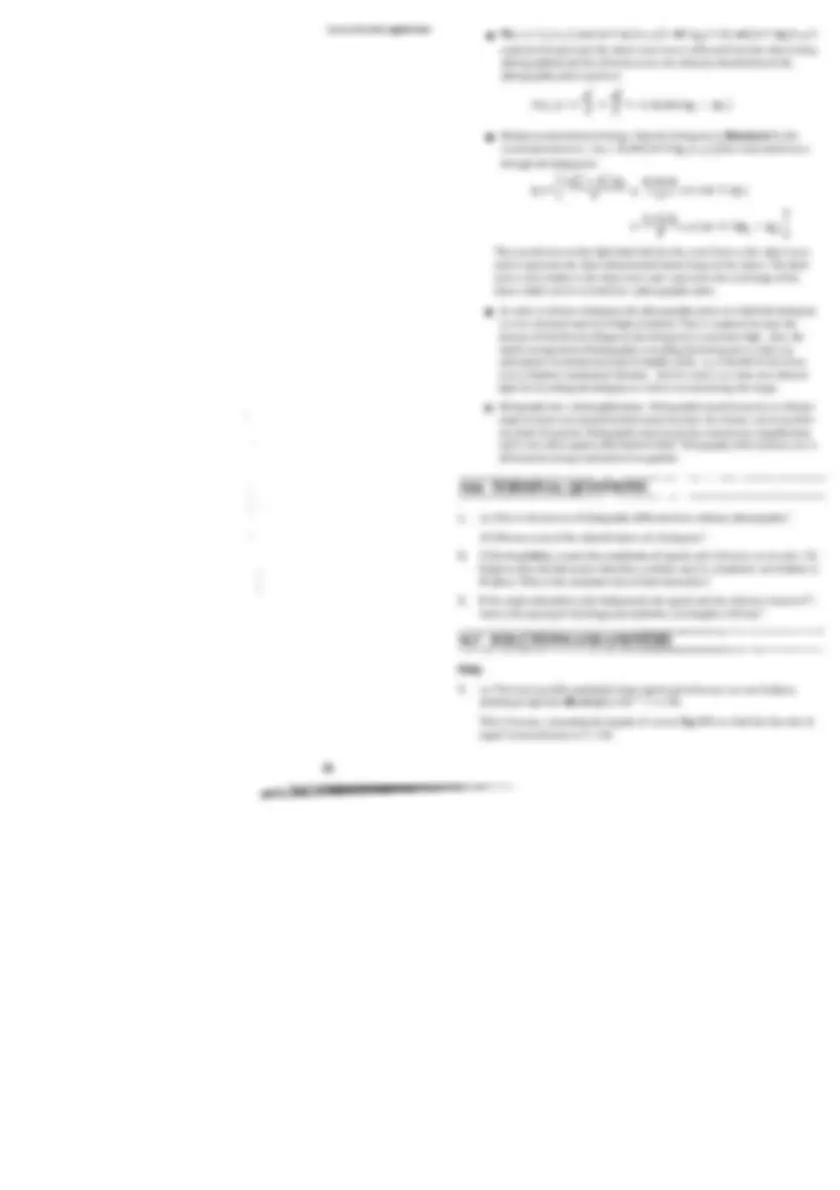
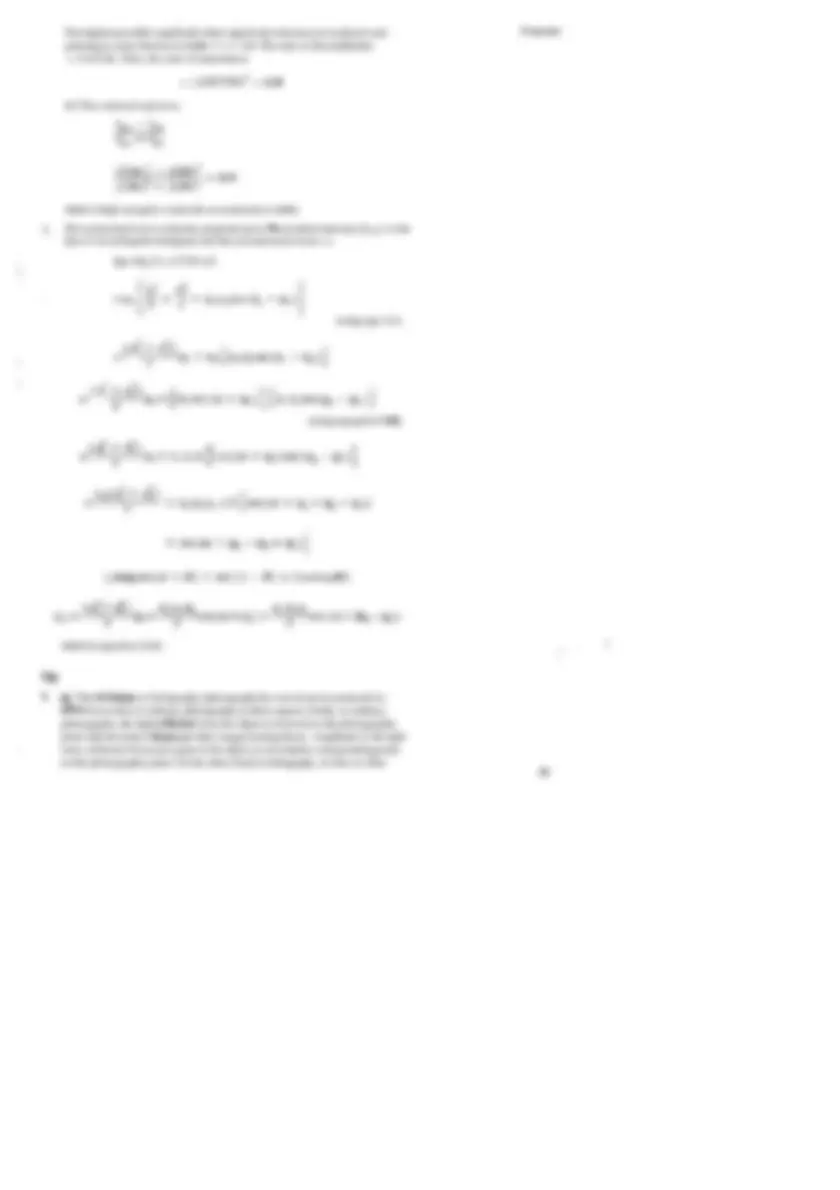
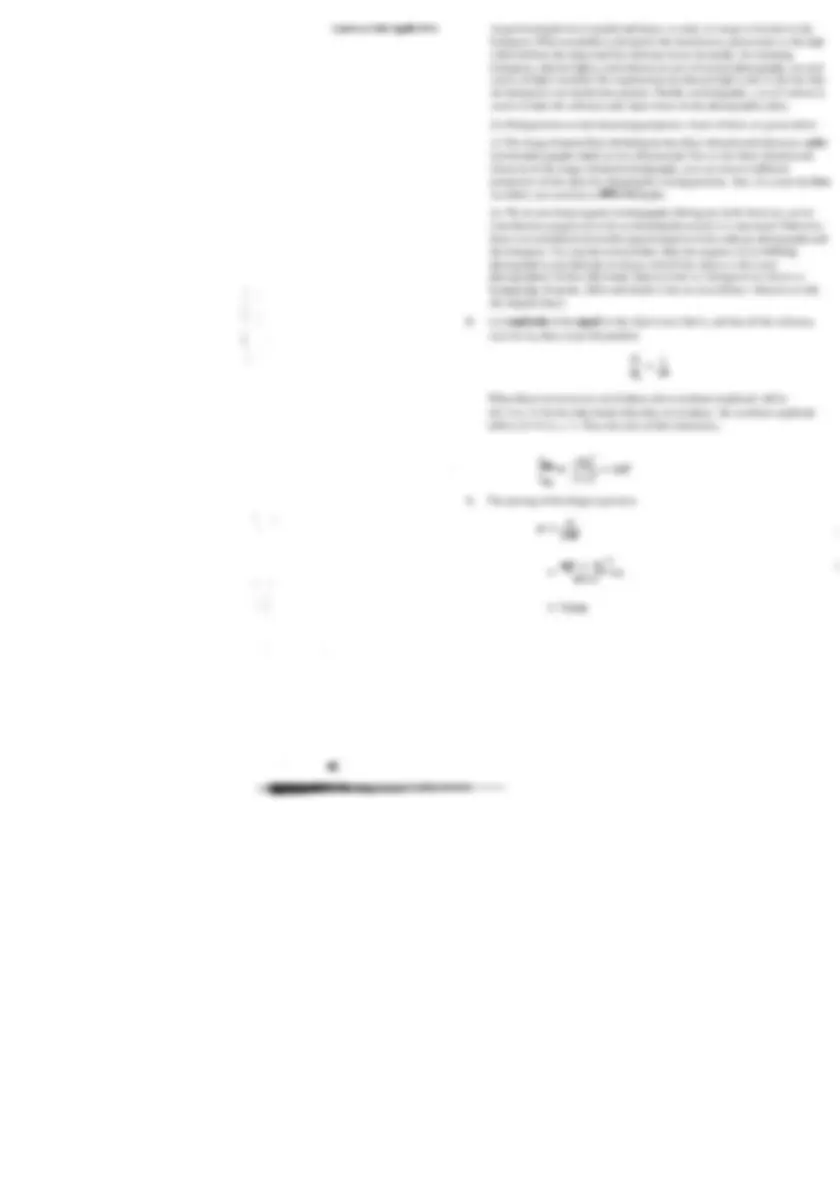


Study with the several resources on Docsity

Earn points by helping other students or get them with a premium plan


Prepare for your exams
Study with the several resources on Docsity

Earn points to download
Earn points by helping other students or get them with a premium plan
Community
Ask the community for help and clear up your study doubts
Discover the best universities in your country according to Docsity users
Free resources
Download our free guides on studying techniques, anxiety management strategies, and thesis advice from Docsity tutors
The basic principles of holography, a technique of obtaining a complete three-dimensional picture of an object or a scene. It describes the process of holography, including the production of a hologram and the reconstruction of an image. The document also discusses the applications of holography and the differences between holography and normal photography. practical considerations in holography and terminal questions with solutions and answers.
Typology: Study notes
1 / 16

This page cannot be seen from the preview
Don't miss anything!










Lasers nnd their Applications (^) Hence,
2.
Given,
Power = Encrgy per unit time
= Energy Time Power = 100W = 100 ( J/s )
Time = lOms = 10 x l o b 3 ( s ) Energy = Power x Time
= IOO(J/S) x 10 x
= 1J.
UNIT 14
14.1 Introduction Objectives 14.2 Holography: The Basic Principle 14.3 Holography: The Process Production of Hologram Reconstruction of Image Practical Considerations in Holography 14.4 Applications of Holography 14.5 Summary 14.6 Terminal Questions 14.7 Solutions and Answers
14.1 ODUCTION
In the previous Unit, we pointed out that one of the revolutionary applications of lasers I is in the development of a novel technique of photography, known as holography. This
That is, holography is the technique of obtaining complete picture (as true as the object itself) of an object or a scene. In other words, it is a three- dimensional recording of an object or a scene. Well, you may be wondering as to what essentiallydifferentiatesthis technique from the normal photography! In normal photography, a two-dimensional image of a three - dimensional object is recorded on a photosensitive surface. The photosensitive surface records the intensity distribution of light falling on it after reflection from the object. As a consequence, we obtain a permanent record of the intensity distribution that existed at the plane occupied by the photographic plate when it was exposed. Since the photosensitive surface is sensitive only to the intensity variation, the phase distribution existing in the plane of the photographic plate is completely lost and is responsible for the absence of the three - dimensionalcharacter in it. Holography is that technique of photography where not only the amplitude (and hence the intensity) but also the phase distribution can be recorded. As a resilt, pictures obtained by holographic technique possess three -dimensional form and are visually rich. Holography was introduced by Dennis Gabor in 1948. H e showed that one could indeed record both the amplitude and the phase of a wave by using interferometric principles. In Sec. 14.2, you will learn the basic concepts involved in the holographic technique. You will be able to appreciate the similarity between the hologram and the diffraction grating. The process of holography i.e. how to obtain a hologram, how to obtain images from the hologram etc. has been explained in Sec. 14.3. Due to high cost of lasers, (an essential reqdirement for holography) this technique is not being used extensively. The technique, however, has tremendous potential and some of the important applications have been explained in Sec. 14.4.
After going through this unit, you should be able to
I differentiate between normal photography and holography I explain the basic principle of holography I (^) describe how holograms are obtained, and I
i 1 L I
a sufficiently strong reference beam to the random - phase signal is shown. As a result, the phase of the resultant of reference and the signal becomes similar to that of the reference alone. Thus contributions from different pixels produce an interference fringe pattern.
Reference beam (^) Scatlered light (signals)
Fig. 14.2: Addltlon of a strong cohcmnt mfennce beam (top leN) wltlr random-phmc signals (top rlght) glvcs slmllnr resultant (botiom).
The essence of holography is that the process of image formation is being interrupted and splitted into two. In the first step, the object is transformed into a photographic record, called the hologram and in the second step called reconstruction, the hologram is transformed into image. No lens is needed in either step. You may now like to answer an SAQ.
SAQ 1
Using the size of the amplitude vectors drawn in Fig. 14.2 calculate
(a) the ratio of-intensities, and (b) the contrast resulting from these intensities.
Spend 3 min
At this stage, you may say that in photography, what we essentially record is the light reflected from the object and not its dirfraction pattern. Well, it is 'easy to extend the basic idea of holography, explained above in terms of ~abor'izone-plate, to the actual photography situations. Reflected light waves, like other waves, are described by their amplitude (or intensity) and their phase (or frequency). To capture the wave pattern completely (that is, to obtain the hologram) both the amplitude and the phase of the wave must be recorded at each point on the recording surface. As you are aware, recording of the amplitude portion of the wave is achieved in normal photography by converting it to corresponding variation in the opacity of the photographic emulsion. The photographic emulsion is, however, insensitive to phase relations. In holography (also known as wave- front reconstruction), the phase relations are rendered visible to the photographic plate through the technique of interferometry. You may recall from block- 2 of this course that interferometry converts phase relations into corresponding amplitude relations.
When two plane waves derived from a common source impinge at different angles on a screen, they produce a set of uniform, parallel interference fringes. The spacing of the fringes depends solely on the angle between the impinging waves (that is, on the path
difference between them). A photographic recording of such a fringe pattern results in a grating- like structure. In case of holography, one of these waves is the one reflected from the object (called the object wave) and hence need not be a plane wave. The wavefront of the reflected wave will be highly irregular because of the unevenness of the
object surface. When this irregular reflected wave pattern interferes with the reference wave, the resulting interference pattern will not be uniform. Rather, it will have irregular interference pattern - the irregularity of the impinging wave fronts. At places where the
Holography
49
Losers and their Applications (^) signal bearing waves (the object wave) have maximum amplitude, the interference
fringes have the greatest contrast and vice-versa. Thus, variations in the amplitude of the object wave menifest as the variation in contrast of the recorded fringe pattern. Can you recall the implications of the spacing of the interference fringes? It is related to the path difference (and hence the phase difference) between the two interfering waves. And the path difference, in turn, depends on the angle between them. Larger the angle between the two interferingwaves, more closely spaced will be the fringes and vice-versa. Therefore, variations in the phase of the object wave menifest as the variations in the spacing of the fringes on the photographic record (the hologram). Thus, in a hologram, both the amplitude and the phase of the signal-bearing wave (the object wave) are preserved as variations in the contrast and spacing of the recorded interference fringes respectively.The hologram obtained in this manner has many properties similar to the diffraction grating about which we will discuss in the next section. When this hologranl is illuminated by light of appropriate wavelength, a three- dimensional image of the object can be obtained.
As mentioned earlier, the process of image formation by holography is a two step process. In the first step, the waves reflected from the object are recorded in such a way that complete information regarding the amplitude and phase variations is preserved. This recording of wave-front is called the hologram. The second step involves the reconstruction of an image of the object by illuminating the hologram by light wave called reconstruction wave (which is identical to the reference wave). In the following, we discuss these two steps and also mention some of the practical considerations about the holographic technique.
Holograms can be produced in several ways depending upon the relative orientation of the reflected (or scattered) and the reference waves. For example, Gabor's zone - plate, which is nothing but a hologram, is the record or interference between the two waves travelling more-or-less in the same direction. This is easily done with objects that have enough open spaces between them, such as a wire mesh or opaque letters on a clear (^) , background (Fig. 14.1~).Signal and reference, in other words, travel in the same direction. Such a hologram is called Gabor hologram or in-line hologram. It was only after the invention of laser that this novel techniquc of photography became truly practical. With the help of lasers, N. Leith and Juris Upalnicks' produced what is known as off-axis hologram. In the off-axis hologram, the reference beam and the object beam I arrive at the recording plate from substantially different directions. This made possible (^) I holography of solid three dimensional objects. Now, the question ariscs: How holograms are recorded? To understand this, refer to Fig. 14.3. A beam of cohere laser light (in which all points on the wavefront are in phase) is split into two beams. One beam illuminates the object to be recorded and the light reflected from this object falls on a photographic plate. The other beam, called the reference beam, is reflected from a mirror to the same photographic plate. Due to superposition of wavefronts of these two beams, an interference pattern is recorded on the photographic plate. The record on thc photographic plate (hologram) is simply a pattern of interfering wavefronts and shows no resernblence to the recorded object. The hologram, however, contains "all the information" about the object.
Ordinarily, these interference fringes are very closely spaced and cannot be seen by unaided eye. Hence the hologram appears to be uniformly gray. When seen by
b e t s and their Appllcatlons
and the reference wave as
You may notice that the amplitude of the reference wave is not a function ofx ory (the
the photographic plate, On the other hand, the amplitude of the object wave,Al, is a function ofx andy because it will vary from point to point on the photographic plate due to reflection from the object. Similarly, the phase of the reference wave @2 wilt be constant if it (the reference wave) falls normally on the photographic plate and will be
however, a function ofx andy. When these two waves arrive at the photographic plate, the total field distribution will be
As you know, the photographic plate responds only to the intensity. Thus, to get the intensity distribution on the photographic plate, we must take the time average of ( 3 ,oh, l2 i.e.
intensity pattern on the phorographic plate.
1 Now, as mentioned earlier, during the reconstruction process, the interference pattern on the photographic plate (called hologram) is illuminated by a reconstruction wave. Let
;~r-.~twill be the natpre of the transmitted wave when the reconstruction wave falls on ihc hologram? Well, the hslogram is exposed in such a manner that the amplitude transmittance is linearly related to I (x,y), the incident intensity at the time of recording. So, we have, the trksmitted wave
Holography
Starting from the relation
derive Eq.(14.6) using Eqs. (14.4) and (14.5)
The transmitted wave represented by Eq. (14.6) consists of three terms. What do these term signify physically? The first term is the reconstruction wave (v3) with its amplitude modulated by the amplitude of the object wave ( A l ). It is so because Al is a function ofx andy whereas the reference wave amplitude A , is a constant. As a result, this part of the , transmitted wave will travel, with slight attenuation, in the direction of the reconstruction wave, The second term is identical to the object wave ( q 1 ) except for the constant term ( A 2 A 3 ) / 2. Here lies the beauty of holography. The hologram and the reconstruction wave have generated a wave which is in every way identical to the wave which originated from the real object itself while recording the hologram. This part of the transmitted wave forms a virtual image of the object. The third term which is similar to the object wave forms a real image of the object. As a result, a three - dimensional picture of the object can be obtained by placing a camera in the position of real image. The reconstruction process alongwith various parts of the transmitted wave is shown in Fig. 14.5. You may note that the object is not present when image is reconstructed. However, one of the evolving beam, resulting due to reconstruction process, is identical to the beam reflected by the object at the time of recording the hologram.
Re h e n c e Virtual^ imagc^ Rcnl^ itnagc wave (a) (b)
Fig. 14.5: (a) Recording the hologrorn:Wave reflected from an obJtci lntrrlereswllh the reference wave. (II) Reconstr~~ctlon:The hologrnrn diflracls the reconstrucilonwave, I resulting In transmltted wave which produces a real and a virtual image.
So far we have discussed physical principles and the experimental arrangements of holography. Suppose you are in the actual process of producing holograms and its subsequent reconstruction to obtain a threedirnentional image of the object. What are the important aspects of the process, and components used therein, about which you should be careful? Well, theie are several practical considerations in holography which are
I very small distances or thicknesses (of the order of wavelengths of light) etc. Testing for I (^) stresses, strains and surface deformation is one of the most useful practical applications of holographic interferometry.
In the double - exposure technique of holographic interferometry for measuring
loading, and the other after (i.e. under strain). The original object and the object after deformation are recorded holographically on the same photographic plate. The hologram thus obtained is a double exposure, with the second pattern of wave fronts superposed on the first. When this hologram is reconstructed by illuminating it with the reference wave, both images are viewed simultaneously. Since they are slightly different due to deformation, the two images interfere. Thus, any distortion of the ohject will show in the form of fringes. Like other kinds of interferometry, the technique readily detects changes that produce optical -path difference of the order of a fraction of the wavelength of light, And unlike normal interferometry, however, it is possible to perform experiment quite readily with almost any type of material.
3 Microscopy has been the primary area of^ applicatioil^ of holography. In fact,^ Gabor's discovery of this tecnique was the outcome of his attempt to enhance the resolving power of an electron microscope. In contrast to a conventional high power microscope, a holographic microscope has an appreciablc depth of field and it need not be focussed at all. To see how a holographic microscope [unctions, refer to Fig. 14.6. The light beam from laser is split into two. One beam is passing through the specimen and through the microscope, and the other beam is led around it. The two beams interfere on the film, producing hologram. The reconstructed image can be viewed in ally desired cross- section. The observer merely looks at the cross-section, he or she wishes to see, moving back and forth throughout the depth of the image without the object being present at all. I
Information can be stored and retrieved more efliciently in the forin of holograms than
Hologrnphy
h e r s and their AppUeatlons (^) only reconstruct the holographic image if the reconstruction beam is incident on the
hologram at the correct angle. Due to this property, several holograms can be recorded on the same holographic plate by using a slightly different angle between the object and the reference beams for each hologram. Thus, on reconstruction, depending upon the angle of incidence of reconstruction beam, a particular holographic image will be visible. Perhaps this is how information is stored in the brain. If that is the case, it would help explain why attempts to locate certain centres in the brain never met with much success and why brain injury often does not lead to predictable circumscribed defects.
One of the most exciting applications of holography is the pattern recognition, also called the character recognition. Early pattern recognition systems, before hol~graphy came on the scene, were based on geometrical optics. Consider, for example, that we want to read the IetterA (Fig. 14.71.A set of charactersA, B, C ... are printed on a strip
matches the character on the film, the output from a photo detector is zero, triggering a printer. But, in reality, this does not work. The character and the negative must be aligned perfectly, both in position and size, which is an unrealistic requirement.
Modern pattern recognition systems are based on holography. In place of a mark containing the real imagge of the letter A we may use the hologram of the letter A.
Fig.14.7: Pattern recognilionbased on geometric optics
As in holography, hologram of the IetterA is the superposition of two sets of wavefronts, the signal and the reference. The signal is diffracted by an original A and the reference is a beam of collimated light. Subsequently, when the hologram ofA is illuminated with light from anotherA, plane wavefronts arise that can be focussed into a bright spot (Fig. 14.8 top). The spot can easily be recognised by eye or photoelectrically. On the other hand, if the wavefronts are coming from B or from other characters, they do not transform into perfectly plane wavefronts and do not produce a focussed spot. Instead, a diffuse patch of light (centre) is produced. Hence, we can scan a given matrix of characters and determine whether or not a particular character is present (bottom).
Lasers nnd their Applicalions
respectively represents the object wave (wave reflected from the object being photographed) and the reference wave, the intensity distribution on the photographic plate is given as
During reconstruction of image, when the hologram is illuminated by the reconstruction wave, (q3 = A3 cos [ wt + q5Z ( X , y ) ] the transmitted wave through the hologram is [(A: + A: 1 ~ 3 A,A,A, q4= , 2 + -------. 2 cos^ (^ wt^ +^ )
+-^ A 1 A 2 A 3
The second term on the right hand side has the same form as the object wave and it represents the three-dimensional virtual image of the object. The third term is also similar to the object wave and represents the real image of the object which can be recorded on a photographic plate.
In order to obtain a hologram, the photographic plate on which the hologram is to be obtained must be of high resolution. This is required because the density of interference fringes in the hologram is extremely high. Also, the whole arrangement of holography- recording the hologram as well as its subsequent reconstruction-must be highly stable, i.e. it should be free from even a slightest mechanical vibration. And of course, we must use coherent light for recording the hologram as well as reconstructing the image.
1. (a) How is the process of holography different from ordinary photography?
2. Following Gabor, assume that amplitudes of signals and reference are in ratio 1:lO. Suppose that the two beams when they combine may be completely out of phase or
what is the spacing of the fringes provided the wavelength is 492 nm?
SAQs
1. (^) (a) The least possible amplitude (when signal and reference are out of phase,
This is because, measuring the lengths of vectors Fig.14.2, we find that the ratio of signal versus reference is 1 : 4.36.
The highest possible amplitude (when signal and reference are in phase) and
= 3.3615.36 , Thus, the ratio of intensities is
(b) The contrast is given as
which is high enough to make the reconstruction visible.
L J (using egn 14.4)
(using equaqtion 14.5)
1. (^) (a) The technique of holography (photography by wave front reconstruction) d i e r s from that of ordinary photography in three aspects. Firstly, in ordinary photography, the light reflkcted from the object is received on the photographic plate with the help of lenses.or other image forming device. Amplitude of the light wave, reflected from each point of the object, is recorded at corresponding point
UNIT 15 FIB OPTICS
.I' Structure
Objectives 15.2 OpticaI Fibre Types of Fibre Applications of Optical Fibre 15.3 Optical Communication through Fibres Pulse Dispersion : Step-Index Fibre Pulse Dispersion : G N N Fibre Material Dispersion Power Loss 15.4 Summary 15.5 Terminal Questions 15.6 Solutions and Answers
You might have seen advertisement dispalys (made of glass or plastic rods) and illuminated fountains. While looking at these, you might also have noticed that Iight seems to travel along curved path. In the above mcntioncd cases, most of the incoming light is contained within the boundaries of the medium (glass or plastic or water) due to the phenomenon of total internal reflection. And since the medium itself has a curved shape, the light travelling through it appcars to travel along a curved path. Optical fibre, which is made of transparent glass or plastic, also transmit light in a similar fashion. These fibres a r e thread like structure and a bundle of it can bc used to transmit light around corners and over long distances. Since optical fihrc can transmit light around corners, it is being used for obtaining images of inaccessible regions e.g. the interior parts of human body. The real potential of the optical fibrcs was, however, revealed only after the discovery of lasers. ' (^) You may recall from Unit 13 of this course that the discovery of lasers - a source of
I coherent and monochromatic light^ -^ raised the hope of rcalising communication at optical frequencies. Since increase in frequency of the carrier wave enables it to carry more information, communication at optical frequencies ( - 1015 Hz) has obvious advantages over commu~~icationat radio wave ( - 10^6^ Hz) and microwave ( - 10 Hz)^9 frequencies. But, early attempts at communication at optical frequencies faced a major problem. When optical radiation travlcs through the Earth's atmosphere, it is attenuated by dust particles, fog, rain etc. Thus, a need for an optical waveguide was felt and the answer was the optical fibres. Optical fibres are an integral part of optical communication - transmission of speech, data, picture or other information - by light. In this unit, you will study about the optical fibres, especially in the context of optical cammunication.
In Sec.15.2, you will learn the physical principles involved in transmission of light through fibres. Types of fibres used in optical co~nmunicationhas also been explained. General considerations about the optical communication through fibres has been discussed in Sec. 15.3. In the same section, you will also learn about the requirements which must be met by optical fibres so that efficient optical communication may take place. The area of optical fibrc is relatively new and an cxciting Geld of activity. A thorough understanding demands rathcr sophisticated mathematical background on the part of the student. It has, therefore, been attempted herc to kcep the mathematical aspects to a bare minimum and thc underlying physical principles have been highlighted.
Fibre Optics